Can hidden food sensitivities make you gain weight? Can food intolerances stop or impair weight loss? Does food sensitivity testing help with losing weight? How hidden food intolerances make you gain weight?
This post endeavours to answer many of these questions based on the clinical evidence we gathered.
Here I present and discuss a remarkable clinical case of significant weight loss facilitated by the IgG food sensitivities testing and following the elimination diet based on the test results. Food is a powerful medicine and you won’t get well without acknowledging and respecting this fact.
So, if you’re not aware of or doubt the power of tailored nutrition, you need to read this case report!
Table of contents
- Introduction [1]
- Methodology [2]
- Weight loss based on food sensitivity testing: A case study [3]
- Clinical Case Presentation [4]
- Clinical Findings [5]
- Therapeutic Focus – Food as Medicine [10]
- Progress timeline [11]
- Main findings [13]
- Karen’s weight loss story in her own words [14]
- How to do IgG food sensitivities testing [15]
- Our clinical study on IgG food sensitivities testing [16]
- Summary [17]
- References [18]
- Additional resources [19]
Introduction
Recent studies have found that approximately 15-20% of adults experience food sensitivities or allergies [20]. According to research, certain conditions and symptoms may be exacerbated by food sensitivities. These include weight gain and obesity [20], chronic disease [20], and migraines [21].
Food sensitivities are on the rise due to the immune system response to partially digested proteins in foods that can ‘escape’ from the gut if the gut is ‘leaky’ – read more about leaky gut (also known as gut permeability) [22]. When triggered by these undigested proteins, the immune system releases immunoglobulins (or antibodies) that are produced by the white blood cells. These antibodies then bind to the problematic proteins in order to remove them from circulation.
There are several types of immunoglobulins (Ig) that have different functions, with IgA, IgE, IgG, IgM being the most known. Immune responses involving Immunoglobulin type G (IgG) are characterised by the delayed response food reactions i.e. taking 1-3+ days to appear.
That means if you eat the food you’re sensitive to today, it may take 1-3 days for symptoms to appear. Because of this time delay It’s hard to know which foods cause the symptoms. Therefore, food sensitivity testing that identifies these type of foods is so important. To understand the exact mechanisms involved, please read my detailed description of IgG food sensitivities [23].
As mentioned above, weight gain and obesity appear to be a factor in the development of food intolerances. Inflammation also contributes to increased intestinal gut wall permeability (leaky gut), thus potentially elevating levels of IgG antibodies to foods in the blood stream [20].
I utilise IgG food sensitivities testing in a food-based weight loss method involving following an elimination diet based on the test results. When indicated, I also add a small number of targeted supplements to address deficiencies of key vitamins and minerals, as identified by the blood tests and symptom analysis.
This method is proving to be safe and effective in enabling weight loss mechanisms in the body, by removing inflammatory foods and drinks, drinking purified water [25], improving digestion and elimination, and making a few important lifestyle adjustments [26] to support and speed up the weight loss process.
In this post I present a case report of a weight loss client applying the above method in practice and getting remarkable results.
Methodology
Based on the clinical experience gained during the management of a number of IgG testing cases, I developed a tailored methodology utilising key steps involved in achieving optimal results for clients. The sequential stages are organised into a clear and doable steps, where a client and a practitioner work closely together to facilitate optimal health and wellness outcomes.
Main steps involved include:
- In-depth naturopathic health assessment using a tailored health questionnaire covering client’s health history combined with an assessment of main body systems, nutrition patterns and lifestyle habits.
- Identification, initial rating and prioritising of current symptoms prior to taking the IgG food sensitivity test.
- Referral for basic blood tests to assess overall health status and identify key nutritional deficiencies of vitamins and minerals necessary for the body to start the repair process.
- Referral for the IgG food sensitivities blood test.
- Test results interpretation, agreeing on the priorities and implementation steps.
- Symptom review at each consultation – each client is asked to record and rate their symptoms in a ‘symptom tracker table’ on a weekly basis. This is reviewed and discussed at each consultation to remove any road blocks as they arise.
- Frequency of consultations – depending on a client’s needs, their nutritional literacy, ability to cook or work commitments. Consultations typically take place every 4-5 weeks. Therapy duration: around 6-12 months.
- Tools and aids utilised throughout the program include:
- Detailed nutrition guides covering food groups that need to be eliminated for a period of time (e.g. gluten-, diary-, egg-, yeast-, soy-free)
- Relevant food substitute lists e.g. gluten free flours, dairy alternatives
- Best food preparation methods for optimum digestion and absorption
- ‘Safe’ product lists and where to get them
- Personalised, tried and tested recipes and menus covering all meals
- Lifestyle modifications guidelines to support recovery including improving sleep, stress management, rest and relaxation, exercise, etc.
Weight loss based on food sensitivity testing: A case study
Karen, a 51-year-old female, was referred to me by Nicholas Greene of Greene Chiropractic [27], a holistic chiropractor I work with, who suggested she does the IgG food sensitivities testing as the first step to initiate weight loss in a safe manner.
When we first spoke, Karen’s main health concerns and goals were:
- “Weight gain – this has been gradual over the last 11 years. I lost 30 kilos 23 years ago with Jenny Craig, and slowly gained it back. I was at a comfortable weight 90kg about 11 years ago and since have risen to 115kg. I don’t feel comfortable at this weight. My legs and varicose veins have started to flare up again – and I have an enlarged belly, so to lose weight would be WONDERFUL”
- “I would like to learn how I could eat healthier and perhaps lower my cholesterol or, if nothing else, learn more about myself, my body, and how best I can help it function better”
- Her weight goal was 85kg. Her initial weight was 115kg, Height: 175cm
Clinical Case Presentation
In addition to being overweight, Karen experienced the following symptoms/ signs:
- Low energy, need for ‘pick me ups’ like sugar and coffee
- Daily fatigue and tiredness
- Menopausal symptoms – hot flushes at night interfering with sleep, night sweats, memory problems, brain fog
- Significant sugar cravings resulting in a regular sugar intake during the day
- Dry skin
- Swollen ankles
- Dark circles and bags under the eyes
She wasn’t taking any medications or supplements.
Clinical Findings
Symptom analysis: identifying existing imbalances likely causing symptoms
- Check for and exclude key nutritional deficiencies (vitamin D, zinc, vitamin B12, iron, other) – she was referred for blood tests to establish a baseline at the start of the nutritional therapy
- Likely insulin resistance (previously detected via blood tests) and blood sugar imbalances. Related symptoms/ signs included:
- Excess weight, extra weight in abdominal region
- Memory and concentration problems, brain fog
- Sweets, cakes and coffee cravings
- Fatigue relieved by eating
- Skin tags
Nutrition
- She ate a mixed food diet and didn’t restrict any foods or food groups
- Karen had poor eating habits with irregular eating patterns, skipping breakfast and lunch because she ‘was busy’
- She started her day with a coffee, followed by a processed cereal. Then continued with wholemeal bread sandwich for lunch, cakes/ sugar for snacks, and had more nutritious dinners of mainly meat and vegetables.
- Her daily water intake was low for her weight but her coffee/tea consumption was high – on average she had 3 glasses of tap water per day, plus 4-5 coffees per day and 1-2 black teas. Therefore, dehydration was an important factor to address.
Lifestyle
- Energy levels: good in the morning, exhausted by evening
- Sleep: 8-9 hours per night, sometimes wakes up 1-2 times during the night
- Exercise: not much, mainly walking (around 10,000 steps per week)
- Limited regular sun exposure due to office work; time in nature – once per week on average
- Stress: medium level, mainly at work
Action steps after initial consultation
- Complete a Food Journal for 7 days to evaluate eating patterns
- Perform blood tests to identify nutrient deficiencies impacting digestion and blood sugar imbalances, among others
- Exclude all 34 foods (‘red’ and ‘yellow’) as per the IgG test results – see Table 2
Table 1
Summary of initial symptoms
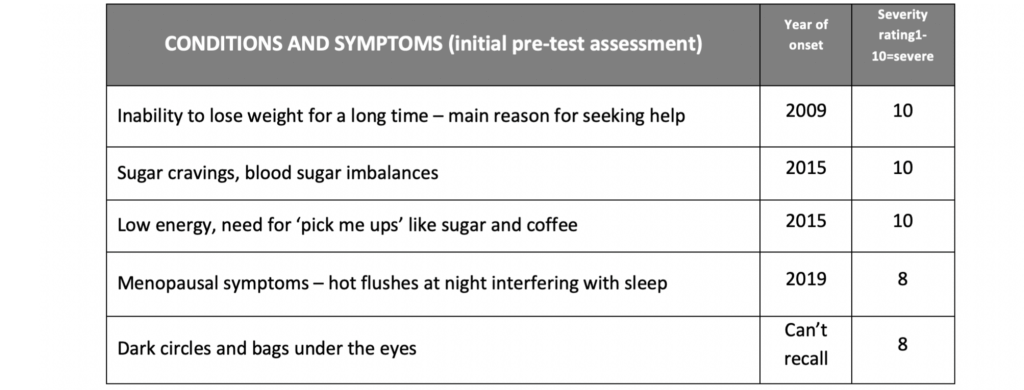
IgG food sensitivity testing: initial results
The IgG test identified a number of high (red) and borderline (yellow) foods as follows:
- 30 ‘red’ elevated foods
- 5 ‘yellow’ borderline foods
- Main food groups identified as problematic were:
- Casein/ all dairy (highest levels of IgG antibodies)
- Gliadin/ all gluten containing grains
- Eggs (white & yolk)
- Other foods included: corn, pea, potato, nuts (4 nuts including almonds), flaxseed and Brewer’s yeast
- See Table 2 for details
Table 2
Initial IgG food sensitivity test results
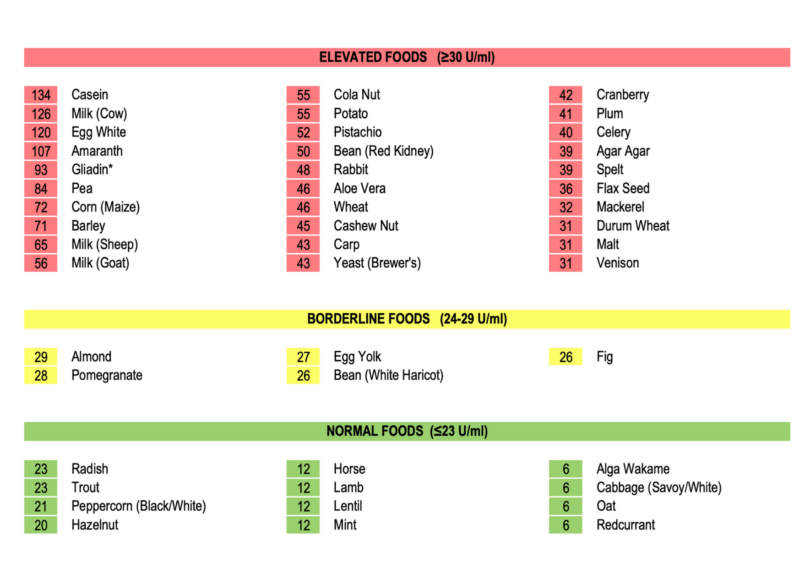
Although overwhelmed by the number of foods to restrict, Karen was very motivated to adhere to the elimination diet, and decided to exclude all ‘red’ and ‘yellow’ foods from the start.
We agreed on an approximate timeline of the nutritional therapy of 6-12 months, with the IgG retest after around 7 months to ascertain which foods could be re-introduced, if desired.
Therapeutic Focus – Food as Medicine
Karen wanted to apply the IgG testing using ‘food as medicine’ first and foremost. Therefore, we agreed to use the elimination diet as the main therapeutic tool, and only address key nutrient deficiencies indicated by the blood tests.
The main therapeutic tools included nutrition modifications as per her test results, new ways of meal preparation, using new or forgotten ingredients, such as gluten free flours or diary alternatives. We focused on selecting foods that were marked as ‘normal/ green’ in her test results – see Table 2 above.
She felt overwhelmed at first with the challenge of excluding major food groups (i.e. dairy, grains, eggs) which she consumed on a regular basis, many multiple times daily. Nonetheless, she persisted and started to gradually implement the nutrition guidelines we discussed. This required cooking different type of meals for herself and other meals for her family, which was difficult at first.
Progress timeline
1 month follow up
From the analysis of Karen’s Food Journal, it was clear that breakfast and snacks were the most pressing meals to improve. Therefore, we decided that she focused on them until she feels confident preparing them according to the new guidelines, before modifying other meals. She agreed to follow this recommendation and was supplied with the following nutrition guides:
- Dairy, gluten, egg-free guidelines
- Alternative flours list
- Breakfast and snack suggestions and recipes tailored to her test results
- Portion sizes and sample meal suggestions – important to be aware for weight loss
Importantly, water intake was increased to 10+ glasses per day (including herbal teas). She was also advised to buy a water filter as she was drinking tap water likely contributing to her toxic load, and thus slowing detoxification processes triggered by the elimination diet.
She was asked to continue with the food journal for ongoing analysis and review.
Blood test results revealed a number of nutritional deficiencies (see Table 3 below) that needed to be addressed to support the healing and repair processes. Based on the test results, she was prescribed the following supplements:
- Vitamin D
- Vitamin B12 plus B-complex vitamins
- Liver support
- Blood sugar support
Table 3
Blood test performed after the initial consultation

2 month follow up
Despite a fairly difficult start, Karen quickly got up to speed with the foods she could consume. She started reading labels to exclude products with unhealthy or problematic ingredients. She also searched for online inspiration on healthy recipes and meal ideas, in addition to the recipes and food preparation help provided by me.
Karen decided not to record her food intake on a daily basis but instead sent photos of the meals she made, together with the recipes and ingredients. It was clear she became quite creative with her food choices and was enjoying cooking and experimenting with recipes.
She bought a water filter to use at home and was drinking around 3 litres of water per day, as agreed.
She also started supplementation to address the key nutritional deficiencies identified by the lab tests, as mentioned in the 1 month follow up notes (see Table 3 above).
Karen reported the following changes:
- Weight loss in the past 3 months since starting the elimination diet: 10kg
- Less sugar cravings
- Skin and hair improvements
- More energy, better memory, improved concentration and focus
- Menopause symptoms – [28] about the same intensity as at the start, mainly hot flushes interfering with sleep
Action steps
- Eat improved breakfast and snacks excluding all the ‘red’ and ‘yellow’ foods. Start to apply the guidelines to other meals (lunch and dinner) at own pace.
- Keep going with implementing lifestyle modifications (more movement – incidental and exercise, sun exposure and fresh air on a daily basis).
- Continue with the supplements until retesting at around 6-7 months’ time. Both blood tests and IgG test were to be repeated then.
4 month follow up
At our next Zoom call, Karen reported she lost another 6kg in the past 6 weeks bringing the total weight loss to 16kg in the past 4 months.
This was an optimal weight loss rate for her of around 4-5kg per month, and not creating much stress on the body or mind.
She was very pleased about dropping 16kg, of course, but also said she considered it to be only about half-way towards her weight goal of 85kg. Karen expected the weight loss to slow down in the coming weeks, as it was her past experience when following other diets. To avoid this, we agreed to employ therapeutic fasting to overcome any weight plateaus.
She looked visibly younger, more relaxed and confident when communicating about her remarkable achievements and progress. She said that the family supported her doing the elimination diet and she found it easy to follow it now, knowing there are many substitutes and plenty of allowed (‘green’) foods to eat.
Majority of initial symptoms were improving (see the Initial Symptom Table 1 above); however, menopausal symptoms were getting worse (hot flushes and night sweats), affecting her sleep at night. This was likely related to an overloaded liver that was busy removing toxins coming out of fat stores as she lost weight, as well as detoxing reproductive hormones (i.e. estrogen, progesterone, testosterone, other).
Her skin was also still dry (these are typical menopausal hormone imbalances manifestations) despite significantly improving water intake and adding good oils to the diet. After ascertaining her hydration and good fats intake (she doesn’t eat fish and dislikes taking fish oil), an Evening Primrose Oil supplement was added for hormone balancing and dry skin.
Further weight loss and blood sugar balancing suggestions (nutrition and lifestyle) were given to support detoxification and body repair processes. This included therapeutic fasting – either fasting one day per week for 24 hours or having only one meal per day (dinner). If needed, she could have a snack after around 16 hrs of fasting. She was going to experiment with the two options and report back next month.
Action steps
- Continue with the elimination diet and other diet modifications
- Continue with the supplements
- Try fasting one day per week and observe effects/ symptoms
- Try the provided bread recipes using gluten free flours, no dairy, no eggs, no yeast
- Increase gentle exercise and movement daily
5 month follow up
At our next consultation, Karen reported having a flu in the past 3 weeks. She also had what looked like oral thrush and she experienced a metallic taste in the mouth. She also was thirsty ‘all the time’, despite drinking around 3 litres of water per day. She had very dark circles and bags under the eyes and felt generally unwell. She got in touch with me during this time for help with her complaints.
Overall, she likely had a flu combined with a mild-medium toxin release after following the elimination diet for around 5 months, as her body was ready to release stored toxins. These likely included some heavy metals (hence the metallic taste in the mouth). Her elimination channels and detox system were most likely under stress. Thankfully, she kept drinking large amounts of water throughout and was able to clear toxins daily.
She eventually recovered, however was still not yet back to ‘normal’. Her sense of taste changed and she started to strongly dislike anything sweet – it tasted ‘strange’ to her. She was craving salt instead of sugar. It seems like her taste buds were ‘reset’ during this time.
Importantly, she kept taking her liver and gallbladder support supplements [29] and was consuming specific liver supporting foods, so her body was able to cope with and slowly release the toxins.
Other improvements reported included:
- She lost another 4kg since our last consultation, her total weight loss was 20kg (i.e. down from 115kg to 95kg). She was determined to lose another 10kg to reach her initial weight goal of 85kg.
- Hot flushes decreased significantly, especially after the flu/detox episode, where the liver function likely improved after toxin release (well-functioning liver is key for hormonal balance). She was now sleeping 8-10 hours per night and rarely got up.
- She had very good energy all day long.
- Swelling of hands, legs and ankles decreased significantly.
- Sugar cravings were almost non-existent.
- She enjoyed and was able to fast for 24hrs once per week without feeling hungry.
- She reported feeling cold, more than usual. That could indicate slow(er) thyroid (her thyroid blood test indicated likely a mild hypothyroid condition, this to be checked on repeat blood test). We discussed a few nutrition strategies to improve her circulation to help with cold extremities.
Overall, she was doing well and continued to 100% avoid the ‘red’ and ‘yellow’ foods.
6 – 7 month follow up
She was very excited to report she surpassed her ideal weight of 85kg and now weighed 80kg! That’s 35kg less that when we started 7 months ago.
Overall, she was delighted with the fantastic results so far – her weight loss, the disappearance of most of her symptoms and improved blood test results – see Table 5 and Table 6 below.
Table 5
Symptom tracking table summary throughout therapy
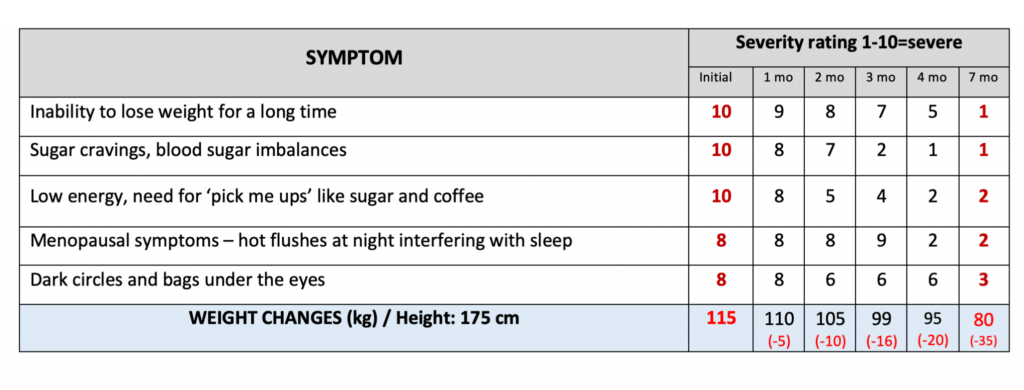
Table 6
Blood tests results comparison
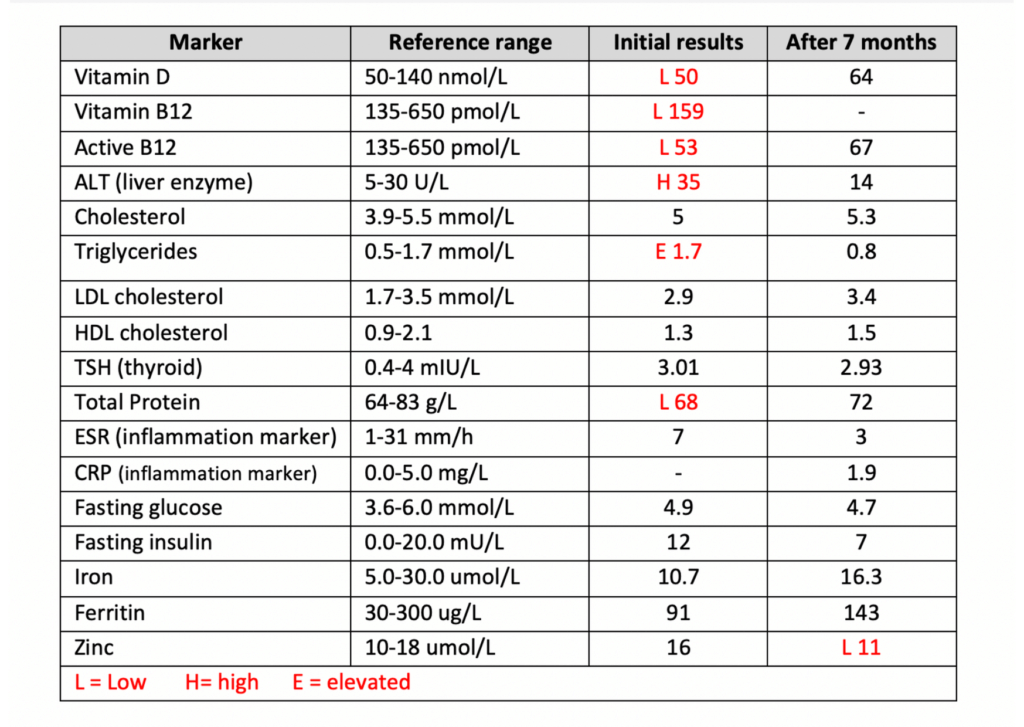
Overall, most key markers improved. However, her zinc level decreased and zinc supplement was added together with recommendations to improve the hydrochloric acid production, important for zinc absorption, through nutrition.
IgG food sensitivities retest results – after 7 months on the elimination diet
After the retest, the number of inflammatory foods significantly decreased as follows:
- ‘Red’ foods down from 30 initially to 10
- ‘Yellow’ foods down from 5 to 4
- Other significant changes:
- Dairy/ casein (protein in dairy foods) – levels decreased from being the number one food in the ‘red’ category (i.e. the highest IgG reaction) requiring elimination of all dairy products, to only cow milk remaining on the red list. She was going to re-introduce goat and sheep milks and butter.
- Gluten/ gliadin (protein in wheat and other grains) – showed as no longer problematic with the exception of barley grain.
She continued following the elimination diet as per her retest results. We discussed the food re-introduction steps, as this process needs to be done slowly and methodically. She was to follow the guidelines for the next 2 months until we talk next.
Table 7
IgG food sensitivity – retest results (after 7 months on the elimination diet)
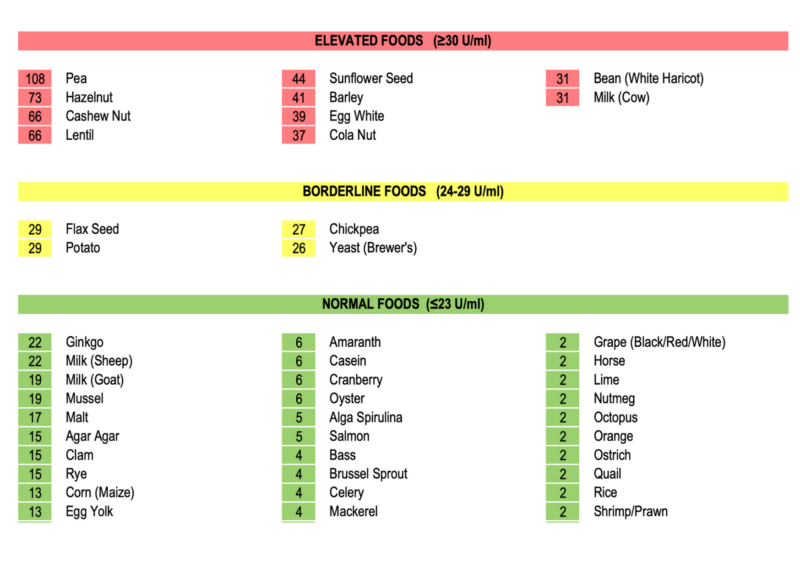
Main findings
Symptom and weight changes over the 7 months on the elimination diet:
- Weight loss of 35kg – 5 kg more than planned!
- A dramatic decrease in symptoms compared to the pre-test scores (see Table 5 above)
- Important improvements in the key blood markers (see Table 6 above):
- Vitamin D
- Active B12
- Liver enzymes
- Triglycerides
- Thyroid
- Protein levels
- ESR
- Fasting glucose
- Iron/ ferritin
- Numbers of ‘red’ and yellow’ foods decreased significantly indicating improved gut function and better functioning immune system (see Table 7 above)
During the time we worked together, she learnt about the importance and the power of personalised nutrition to repair and support the body, from losing weight, improving metabolic rate and blood sugar levels, to having better energy and balancing hormones.
She also recognised the benefits of cooking meals from scratch using good quality ‘safe’ ingredients, as well as having the nutritional knowledge to select suitable products when grocery shopping.
Karen is now able to manage many aspects of her health herself, adjusting her diet and making required lifestyle modification to keep well, and improve further as she goes. She is helping her family members to eat healthier and to be mindful of selecting whole foods over the processed ones.
We agreed to have consultations every 2 months until 12 months on the program to monitor any changes.
Overall improvements: 100% from baseline!
Karen’s weight loss story in her own words
Read about Karen’s personal transformation story, her step-by-step journey to feeling much healthier and happier as written by her [30]. You’ll be moved and inspired!
She said: “I look back on this last year and consider myself very fortunate to have been part of an amazing journey of self-discovery, physical and mental transformation. And to be able to gain my enthusiasm and spark of life back again. This obviously flows through to the family and work. It’s amazing and fascinating how the IgG food sensitivities test is so customised to specifically deal with my issues! I wrote down my experience not to boast, but to encourage. I know how hard it is, especially at the beginning”.
How to do IgG food sensitivities testing
Contact me [31] to discuss your current health challenges and needs.
I offer either Zoom or telephone consultations for Australia-based individuals only, and also see clients in the Sydney CBD clinic [31]. I’m afraid I’m not able to offer any specific treatments or advice to individuals based in other countries at this time.
To book a consultation, click the button below. I also offer a free 15-minute initial discussion to talk about your circumstances and how I can help.
I look forward to connecting with you and to helping you to feel healthier and happier soon!
Our clinical study on IgG food sensitivities testing
Encouraged by the positive results and health transformations of many of our clients, Nick Greene, Chiropractor and I are currently conducting a clinical research study on the applications of IgG food sensitivities testing for our clients suffering from the following conditions:
- Obesity/ overweight
- Gut disorders
- Autoimmune conditions
- Hormone imbalances
Our aim is to gather data, initially covering 50-100 cases across all age groups, and presenting it in a report of findings. We are not aware of any such research undertaken to date, i.e. findings primarily based on the clinical experience/ evidence.
We hope that our findings will contribute to dispelling some of the controversies surrounding IgG testing, and will help to broaden its applications to help more people getting healthier and being well.
If you’d like to take part in our research study, please get in touch with me [31] (Australia-based individuals only).
Summary
For the past few years we sought answers to the many questions surrounding food sensitivities, including their role in weight loss and maintaining healthy weight.
Studies as well as clinical practice show that IgG food sensitivities testing can be successfully used for nutrition-based weight loss therapies, also resulting in either reduction or elimination of many other symptoms. I call it a much wanted side effect or bonus of closely following the elimination diet!
This case report is just one example of how to use tailored nutrition for weight management. I also find that the vast majority of the clients, with various symptoms across multiple body systems, who undertake the IgG food sensitivity test, loose weight just by adhering to the elimination diet guidelines.
Good health and blessings

Joanna Sochan
Wholistic Health and Lifestyle Therapist
Natural and Lifestyle Therapies for Abundant Health and Wellbeing
References
Neuendorf, R, Corn, J, Hanes, D &Bradley, R 2019, ‘ Impact of food Immunoglobulin G-Based elimination diet on subsequent food Immunoglobulin G and quality of life in overweight/obese adults.’ The Journal of Alternative and Complimentary Medicine, vol. 25, no. 2, pp. 241-248.
Lewis, JE, Woolger, JM, Milillo, A, Alonso,Y, Rafatjah, S, Jones, SA, Konefal, J et.al 2012, ‘ Eliminating Immunologically-Reactive foods from the diet and its effect on body composition and quality of life in overweight persons’, Journal of Obesity & Weight Loss Therapy, vol. 2 no.1, pp. 1-6.
Hernandez, CMA, Pinto, ME & Montiel, HLH 2007, ‘Food allergy mediated by IgG antibodies associated with migraine in adults’, Revista Alegria Mexico, vol. 54, no.5, pp. 162-168. https://www.ncbi.nlm.nih.gov/pubmed/18693538 [33]
Alpay, K, Ertas, M, Orhan, EK, Ustay DK, Lieners, C & Baykan, B 2010, ‘Diet restriction in migraine, based on IgG against foods: A clinical double-blind, randomised, cross-over study’, Cephalalgia, vol.30, no.7, pp. 829-837. https://www.ncbi.nlm.nih.gov/pubmed/20647174 [34]
Additional resources
- How food sensitivities stop you from losing weight – a case study [35]
- Optimal healthy gut diet plan – a case study [36]
- Parasite treatment considerations: Blastocystis hominis and Dientamoeba fragilis [37]
- Top 3 reasons you’re not losing weight [38]
- Sleep and weight loss connection [39]
Disclaimer : The above material is for informational and educational purposes only. It should not be used to self-diagnose and it is not a substitute for a medical advice, diagnosis, treatment, prescription or recommendation. All viewers of this content, especially those taking prescription or over-the-counter medications, should not make any changes in their health regimen or diet before first consulting a doctor or other qualified health provider with any questions they may have regarding a medical condition or their particular circumstances.

Joanna Sochan is a Natural Therapist and founder of Naturimedica Holistic Wellcare. She has a passion for helping clients transform their lives by becoming healthy and well naturally. Joanna has 12+ years experience in clinical practice and has special interest in solving complex cases, gut health, food sensitivities, hormone imbalances, autoimmune disorders and weight loss. She helps clients individually (mostly online) Australia-wide and also offers online therapeutic programs, eCourses and self-help books. View full bio [40].
